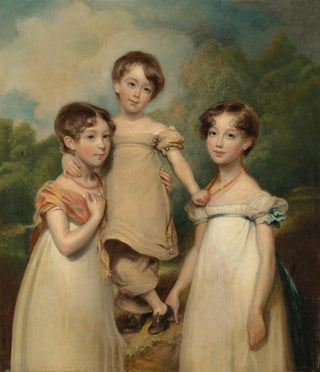Art print | Portrait of the Hughes-Hallett children - John Hoppner


View from behind

Frame (optional)
In the fascinating world of 18th-century British art, the portrait of the Hughes-Hallett children by John Hoppner stands out for its delicacy and expressiveness. This iconic piece, which captures the innocence and freshness of childhood, transports us to a time when portraiture was much more than a simple representation. It was a reflection of society, its values, and aspirations. Hoppner, a master of portraiture, manages to breathe vibrant life into his subjects, and this piece is no exception. Gazing upon this art print, one is immediately struck by how he succeeds in immortalizing not only the faces but also the emotions and bonds that unite these two children.
Style and uniqueness of the work
John Hoppner's style is characterized by remarkable finesse and particular attention to detail. In the portrait of the Hughes-Hallett children, he uses a palette of soft colors that evoke tenderness and innocence of childhood. The children's faces are delicately modeled, their expressions capturing a moment of innocent joy. Hoppner skillfully plays with light and shadow, creating a depth that brings the characters to life. The clothing, carefully rendered, reflects the elegance of the fashion of the time while highlighting each child's personality. The background, though understated, completes the scene without ever overshadowing the main subjects, thus enhancing the intimacy of the scene.
The artist and his influence
John Hoppner, born in 1758, was one of the most prominent portraitists of his time, rivaling figures such as Sir Joshua Reynolds. Although often overshadowed by his contemporary, Hoppner managed to forge a strong artistic identity, marked by his sensitive approach and undeniable talent. He captured the spirit of his era, making his portraits witnesses to British society. His influence endures, not only through his works but also through the artists inspired by his technique and style. By depicting the Hughes-Hallett children, Hoppner does not merely create an image; he immortalizes a time, a social class.

Matte finish

View from behind

Frame (optional)
In the fascinating world of 18th-century British art, the portrait of the Hughes-Hallett children by John Hoppner stands out for its delicacy and expressiveness. This iconic piece, which captures the innocence and freshness of childhood, transports us to a time when portraiture was much more than a simple representation. It was a reflection of society, its values, and aspirations. Hoppner, a master of portraiture, manages to breathe vibrant life into his subjects, and this piece is no exception. Gazing upon this art print, one is immediately struck by how he succeeds in immortalizing not only the faces but also the emotions and bonds that unite these two children.
Style and uniqueness of the work
John Hoppner's style is characterized by remarkable finesse and particular attention to detail. In the portrait of the Hughes-Hallett children, he uses a palette of soft colors that evoke tenderness and innocence of childhood. The children's faces are delicately modeled, their expressions capturing a moment of innocent joy. Hoppner skillfully plays with light and shadow, creating a depth that brings the characters to life. The clothing, carefully rendered, reflects the elegance of the fashion of the time while highlighting each child's personality. The background, though understated, completes the scene without ever overshadowing the main subjects, thus enhancing the intimacy of the scene.
The artist and his influence
John Hoppner, born in 1758, was one of the most prominent portraitists of his time, rivaling figures such as Sir Joshua Reynolds. Although often overshadowed by his contemporary, Hoppner managed to forge a strong artistic identity, marked by his sensitive approach and undeniable talent. He captured the spirit of his era, making his portraits witnesses to British society. His influence endures, not only through his works but also through the artists inspired by his technique and style. By depicting the Hughes-Hallett children, Hoppner does not merely create an image; he immortalizes a time, a social class.






